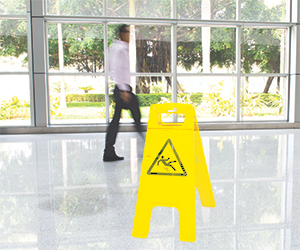How to Avoid Slips, Trips, and Falls on Your Commercial Property
With winter weather comes a heightened risk for slips, trips, and falls in your facility. These incidents can happen year-round, but snow, ice, and slush can raise the risks for building occupants and guests.
 Protect your organization and assets year-round with a smart approach to safety.
Protect your organization and assets year-round with a smart approach to safety.
Sources of Slips, Trips, and Falls
The best defense against claims is making sure accidents never happen in the first place. Common causes include:
Uneven or cluttered walkways: The mats you use to prevent slips on smooth floors can become a trip hazard if they curl or buckle. Chipped or elevated tiles also present a problem, as do cracked or uneven sidewalks and parking lots.
Stairs and steps: Stairs without railings are accidents waiting to happen, and the lack of railings means there’s no way to stop a fall in progress. Areas with just one or two steps, like elevated or lowered dining areas in restaurants, can also cause trips if the small steps aren’t clearly visible.
Poorly calibrated elevators: If an elevator is not calibrated perfectly, when the door opens there may be a lip between the elevator and the floor level. The tenant or guest may not see that and could trip and fall coming out of the elevator.
Slippery surfaces: Whether the cause is inclement weather, a spill, or simply the wrong type of flooring for the application, poor traction is a common cause of falls. Simply putting out a “wet floor” sign during a storm or after mopping won’t cut it.
A lot of property owners think ‘I put the wet floor sign out, so I did my due diligence.’ Wet floor signs are a temporary solution and they’re only to be put out while the problem is remediated. Put in the right type of floor or make sure it does not remain wet. In some cases, the flooring itself might be the problem. A surface like marble or terrazzo that becomes extremely slippery when wet isn’t the best choice for a building entrance, for example. Switching to a cleaning product that’s NFSI-certified to increase the coefficient of friction can help cut down on the likelihood of falls, as can a partial flooring replacement if that’s an option.
Who’s Responsible? It starts with who you’re hiring to service your facility. If your in-house team maintains the facility, one of the things you can control is regular inspections throughout the facility. Documenting inspections is first and foremost in defending yourself against a lawsuit. It’s also vital to have policies in place to prevent as many accidents as possible.
For example, if you’re doing your own snow removal in-house, what protocols are in place in response to changing weather conditions? In harsh winter climate zones, best practice is to immediately clear any sort of hazardous conditions, so that could mean a little ice in the parking lot or on the front walkway or half an inch of snow outside the front door. The key is what standards you had in place and whether you adhered to them.
Do you allow snow and ice to accumulate, or do you have a snow removal contractor on call? Do you have a contract with the snow removal contractor so that they’re there when the snow reaches half an inch? Are they there within the next three to four hours? This extra attention may even save you money down the road by keeping your insurance premiums from rising.
Too many business owners look at falls as the cost of doing business. How’s this as an answer? Prevent the falls and your premiums won’t increase. Every slip and fall costs someone, whether it’s your insurance company or you. Grab hold of it and start managing your money.
By Janelle Penny, BUILDINGS
